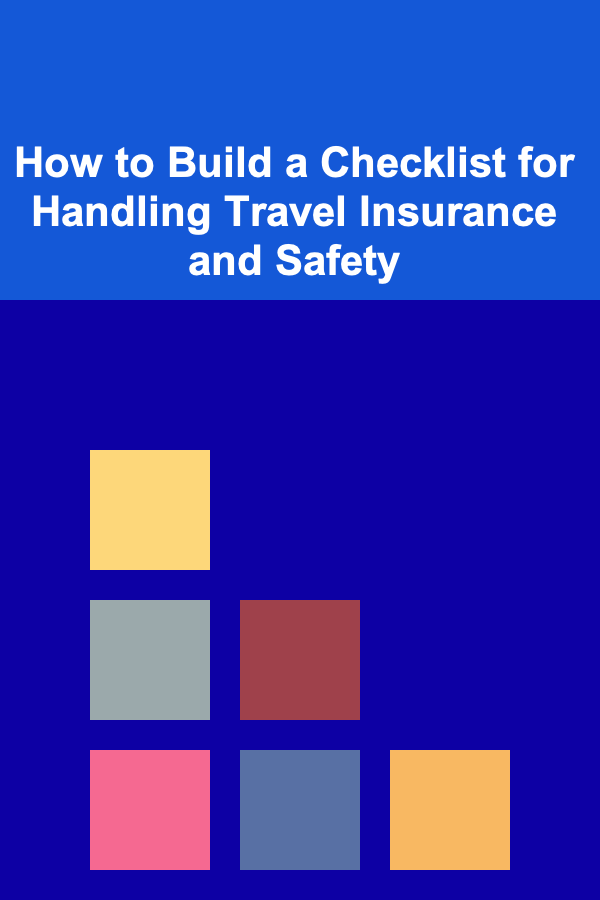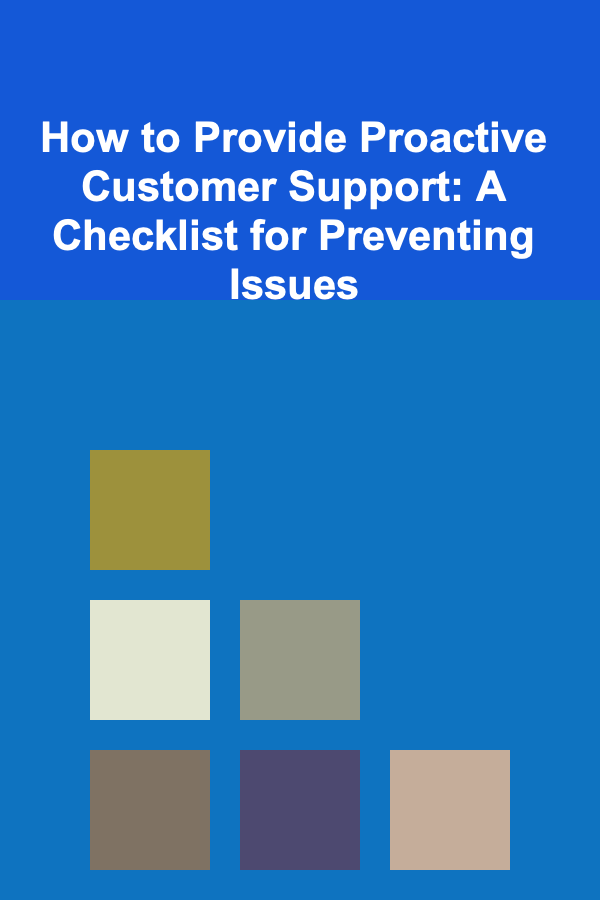
How to Build a Checklist for Handling Travel Insurance and Safety
ebook include PDF & Audio bundle (Micro Guide)
$12.99$6.99
Limited Time Offer! Order within the next:

Traveling, whether for leisure or business, comes with its own set of risks. These risks can include unexpected illnesses, lost luggage, accidents, and even natural disasters. To protect yourself and ensure peace of mind while exploring new destinations, travel insurance and safety protocols are crucial. However, these elements can often seem complicated or overwhelming. That's why having a well-structured checklist for handling travel insurance and safety can make your travels more enjoyable and worry-free.
This actionable guide provides you with the steps and considerations to create an effective checklist for managing travel insurance and safety. The goal is to cover all the bases to ensure you're prepared for potential emergencies, are aware of your rights, and understand the steps to take should something go wrong while traveling.
Understanding the Basics of Travel Insurance
Before diving into the specifics of a checklist, it's essential to understand the different types of travel insurance and what they cover. Travel insurance can be a lifesaver in situations ranging from minor inconveniences like delayed flights to serious issues like medical emergencies abroad.
Key Types of Travel Insurance:
- Trip Cancellation Insurance: Covers the non-refundable costs if you have to cancel your trip due to unforeseen circumstances like illness or natural disasters.
- Medical Insurance: Provides coverage for medical emergencies while traveling, including doctor's visits, hospitalization, and emergency evacuation.
- Baggage Loss/Delay Insurance: Offers reimbursement for lost, damaged, or delayed baggage.
- Travel Delay Insurance: Provides compensation for additional expenses like accommodation and meals if your flight is delayed or canceled.
- Emergency Evacuation Insurance: Covers the cost of evacuating you to a hospital or back home in the event of a medical emergency in a foreign country.
Steps to Build a Travel Insurance Checklist
1. Determine Your Travel Needs
Your insurance needs will vary depending on the destination, duration, and purpose of your trip. Here's how you can start:
- Destination Considerations: Are you traveling to a high-risk destination (e.g., areas with health outbreaks or political instability)? You might need additional coverage for evacuation or medical emergencies.
- Trip Type: Are you traveling for business, leisure, or adventure? Adventure trips (e.g., hiking, diving) may require more comprehensive coverage.
- Health Conditions: If you have pre-existing health conditions, you may need extra coverage for medical issues related to those conditions.
2. Research Different Insurance Providers
Not all travel insurance policies are created equal. It's essential to research reputable travel insurance companies and compare their offerings.
- Policy Coverage: Ensure the insurance covers medical expenses, trip cancellations, and emergency evacuations.
- Claims Process: Look for companies with a streamlined and user-friendly claims process. Check customer reviews to learn about real-life experiences with claims.
- Global Coverage: Ensure that the policy provides coverage across all countries you plan to visit. Some policies may limit coverage in certain regions.
- Exclusions: Carefully read the fine print to understand what is and isn't covered. Exclusions might include certain activities or pre-existing medical conditions.
3. Evaluate Optional Add-Ons
Some travel insurance policies offer add-ons for more specific needs. Consider whether any of these additional options are relevant to your trip:
- Adventure Sports Coverage: If you plan on engaging in activities like skiing, scuba diving, or bungee jumping, look for policies that cover accidents during these activities.
- Rental Car Insurance: If you plan on renting a car, ensure that your travel insurance or credit card provides coverage in case of damage or an accident.
- Terrorism and Civil Unrest Coverage: In certain destinations, coverage for terrorism-related incidents or civil unrest may be crucial.
4. Understand the Claims Process
Being aware of how to file a claim is as important as having the insurance itself. Here's how to prepare:
- Document Everything: Keep receipts, medical records, and any other documentation that might be required for a claim.
- Emergency Contact Numbers: Make sure you have access to emergency contacts for your insurance provider, especially in countries with time zone differences.
- Know the Deadlines: Some insurers have strict deadlines for filing claims after an incident, so make sure you are aware of these timelines.
Safety Measures to Consider While Traveling
Travel insurance is just one aspect of keeping yourself safe while traveling. You should also have a solid safety plan in place to handle unexpected situations. Here's a checklist for safety precautions to consider before and during your trip:
1. Pre-Travel Safety Preparations
- Research Your Destination: Understand the local laws, customs, and potential safety risks. This includes knowing emergency numbers, the location of your country's embassy, and areas to avoid.
- Vaccinations and Health Precautions: Make sure you are up to date on necessary vaccinations and bring any medications you may need.
- Register with Your Embassy: In some cases, especially for high-risk destinations, it is advisable to register your travel plans with your embassy to receive alerts about safety concerns.
- Travel Alerts and Warnings: Keep an eye on government-issued travel advisories for the countries you plan to visit. This can help you avoid dangerous areas.
2. During Travel: Health and Safety Protocols
- Stay Connected: Share your travel itinerary, accommodations, and emergency contacts with a trusted friend or family member. This ensures that someone knows your whereabouts.
- Safety Apps: Download safety and emergency apps that can help you navigate in foreign environments. Apps like Google Maps, emergency medical apps, or apps to track public transport can help you stay on track.
- Protect Your Belongings: Use anti-theft backpacks or money belts to secure your valuables. Be cautious in crowded places or tourist spots where pickpocketing is common.
- Be Aware of Local Scams: Research common scams in the area and remain vigilant, especially in popular tourist destinations.
- Follow Local Health Guidelines: In light of the pandemic and other health-related concerns, adhere to local COVID-19 protocols or other health recommendations in the region.
3. In Case of Emergency: What to Do
Despite all precautions, emergencies can still arise. Knowing what to do in these situations can help you act quickly and minimize stress.
- Medical Emergency: If you fall ill or suffer an injury, contact your insurance provider immediately for advice. They may help with finding a hospital or clinic and cover the costs.
- Lost or Stolen Items: Report lost or stolen items like passports or credit cards to the local authorities and your embassy. Additionally, inform your bank or credit card company to prevent fraud.
- Natural Disasters: In case of a natural disaster, stay informed through local news, and follow the instructions of local authorities. Travel insurance may cover evacuation costs in these situations.
4. Post-Travel Considerations
Once you return from your trip, there are a few post-travel tasks to keep in mind:
- File Claims Promptly: If you had to cancel your trip, dealt with delayed luggage, or experienced any medical incidents, file your insurance claims as soon as possible.
- Review Insurance: Evaluate the insurance policy you used for your trip. If any issues arose or the coverage didn't meet your expectations, consider adjusting your insurance choices for future trips.
Final Thoughts: Staying Safe While Traveling
Having the right travel insurance and safety protocols in place is key to ensuring a smooth and enjoyable journey. By following this checklist for both insurance and safety, you'll not only protect yourself from unexpected incidents but also gain the confidence to fully immerse yourself in your travels. Always remember that the peace of mind provided by knowing you're covered can transform your trip into a memorable adventure, free from unnecessary worry.
Reading More From Our Other Websites
- [Gardening 101] Best Plants for a Low-Maintenance, Drought-Tolerant Garden
- [Home Staging 101] How to Use Furniture Layout to Improve the Flow of Your Home
- [Home Soundproofing 101] How to Block Upstairs Noise with Effective Floor Soundproofing Solutions
- [Organization Tip 101] How to Maintain an Organized E-Book Library
- [Personal Financial Planning 101] How to Build Wealth in Your 40s and 50s for a Comfortable Retirement
- [Home Budget Decorating 101] How to Upcycle Furniture for Affordable Home Decor
- [Home Family Activity 101] How to Set Up a Cozy Family Reading Corner for Quiet Time
- [Home Renovating 101] How to Estimate Roof Replacement Cost: Factors to Consider
- [Personal Care Tips 101] How to Use Teeth Whitening Strips for Sensitive Teeth Without Pain
- [Home Soundproofing 101] How to Soundproof a Window from Street Noise: Effective Solutions

How to Create a Backup Inventory of Your Antique Collection
Read More
How to Incorporate Smart Lighting into Your Home
Read More
How to Make Money Online as a Content Strategist: 10 Actionable Ideas
Read More
How to Provide Proactive Customer Support: A Checklist for Preventing Issues
Read More
How to Implement Electronic Health Records (EHR) Successfully
Read More
10 Tips for a Successful Graduation Party Checklist
Read MoreOther Products

How to Create a Backup Inventory of Your Antique Collection
Read More
How to Incorporate Smart Lighting into Your Home
Read More
How to Make Money Online as a Content Strategist: 10 Actionable Ideas
Read More
How to Provide Proactive Customer Support: A Checklist for Preventing Issues
Read More
How to Implement Electronic Health Records (EHR) Successfully
Read More